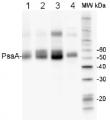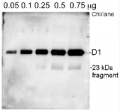1

Anti-PsbA | D1 protein of PSII, C-terminal, DyLight® 594 conjugated (40 µg)
- Product Info
-
Immunogen: KLH-conjugated synthetic peptide derived from available plant, algal and cyanobacterial PsbA sequences, including Arabidopsis thaliana UniProt: A4QJR4, TAIR: AtCg00020 , Oryza sativa P0C434, Populus alba Q14FH6, Physcomitrella patens Q6YXN7, Chlamydomonas reinhardtii P07753, Synechocystis sp. P14660 and many others Host: Rabbit Clonality: Polyclonal Purity: Immunogen affinity purified serum, in PBS pH 7.4, conjugated to DyLight® 594.
Format: Liquid in PBS pH 7,4. Quantity: 40 µg Storage: Store at 4°C for 12-18 months, A preservative may be added for long time storage up to 2 years. Shortly spin the tube before use. Tested applications: Immunofluorescence (IF), Western blot (WB) Recommended dilution: To be determined by end user Expected | apparent MW: 38 | 28-30 kDa - Reactivity
-
Confirmed reactivity: Anabaena 7120, Arabidopsis thaliana, Artemisia annua, Arundo sp,, Chlamydomonas reinhardtii, Colobanthus quitensis Kunt Bartl, Coscinodiscus wailesii, Craterostigma sp,, Ditylum brightwellii, Glycine max, Hordeum vulgare, Lindernia sp,, Miscanthus x giganteus, Marchantia polymorpha (liverwort), Nicotiana benthamiana, Panicum miliaceum, Panax ginseng, Panicum maximum, Pinus strobus, Physcomitrella patens, Synechococcus sp, PCC 7942, Paulinella chromatophora (amoeba), Prochlorococcus sp, (surface and deep water ecotype), Spirodela polyrhiza, Symbiodinium sp,, Zea mays Predicted reactivity: Algae (brown and red), Brassica napus, Conifers, Cyanobacteria, Dictos, Cannabis sativa, Galdieria sulphuraria, Lactuca sativa, Lycopersicum esculentum, Medicago sativa, Nannochloropsis sp., Oryza sativa, Ostreococcus sp. Pisum sativum, Porphyridium purpureum, Sesamum indicum, Thalassiosira pseudonana, Zosteria marina, Vitis vinifera cellular [compartment marker] of thylakoid membrane
Species of your interest not listed? Contact usNot reactive in: No confirmed exceptions from predicted reactivity are currently known, - Additional Information
-
Additional information: Due to biology of PsbA (D1) protein a number of degradation products can apprear in a sample and may be observed when using anti-PsbA antibodies, including products having apparent molecular weights of 24kDa and 16kDa. D1 degradation is a complex set of events and the products observed can be influenced by both the extraction procedure and the physiology of the cells prior to harvest. Third, cross-linking may occur between D1 and cytochrome b559, shifting the protein higher in the gel. In cyanobacteria (PCC7942), three different bands were competed out by preincubating the antibody with the PsbA free peptide, indicating that all bands are indeed PsbA and its precursors or breakdown products. Competition assays were also performed with spinach and Chlamydomonas, confirming the identity of PsbA bands,Anti-PsbA antibodies will not detect D2 protein, as the peptide used to generate PsbA antibodies has no homology to the D2 sequence.
DyLight® 594 has Amax = 593 nm, Emax = 618 nm. DyLight® is a registered trademark of Thermofisher Inc., and its subsidiaries.
Additional information (application): The antibody is appropriate for detecting both, 24 kDa or the 10 kDa C-terminal fragments, whichever is generated under given treatment conditions, In our analysis we have seen both, ca, 24 kDa and ca, 10 kDa fragments from different samples, depending on treatments and isolation procedures,Rabbit anti-PsbA antibody can detect more than one band of PsbA protein, e,g, precursor and mature protein as compare to the hen anti-PsbA antibodies AS01 016,This antibody will detect the phosphorylated form of D1 as an alternate band to the main band on a high resolution gel,The antibody will bind to cross-linked proteins: D1/D2, D1/cyt b559, D1/CP43, - Background
-
Background: The psbA gene has been cloned from many species of plants, green algae, and cyanobacteria. The psbA gene is located in the chloroplast genome and encodes for the D1 protein, a core component of Photosystem II, PsbA/D1 is rapidly cycled under illumination in all oxygenic photobionts. Tracking PsbA pools using the Global PsbA antibody can show the functional content of Photosystem II in a wide range of samples. Alternative names: 32 kDa thylakoid membrane protein, photosystem II protein D1. - Protocols
-
Agrisera Western Blot protocol and video tutorials
Protocols to work with plant and algal protein extracts
Agrisera Educational Posters Collection
- Reviews:
-
This product doesn't have any reviews.
Accessories

AS06 172 | Clonality: Polyclonal | Host: Rabbit | Reactivity: A. thaliana, C. quitensis Kunt Bartl, C. pumilum, C. reinhardtii, C. zofingiensis, F. vesiculosus, H.vulgare, M. polymorpha, N. oceanica, N. tabacum, O. sativa, P. abies, P. sativum, P. strobus, P. vulgaris, S. oleracea, C.reinhardtii, Synechococcus PCC 7942, Synechocystis PCC 6803, Scenedesmus obliquus, microalgae N. gaditana

AS10 939 | Clonality: Polyclonal | Host: Rabbit | Reactivity: [global antibody] for higher plants, algae, cyanobacteria, diatoms
Benefits of using this antibody
50% discount on matching standard/positive control
AS04 042S PsaC | PSI positive control/quantitation standard
Use promotional code: Stand50

AS10 704 | Clonality: Polyclonal | Host: Rabbit | Reactivity: A.thaliana, C.reinhardii, H.vulgare, M.truncatula, N. oceanica, N. oleoabundans UTEX 1185 (chlorophyta), P.patens, P.sativum, S.vulgaris, S.alba, S.oleracea, Synechococcus sp. PCC 7942, Synechocystis sp. PCC6803, Triticum sp.

